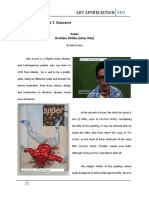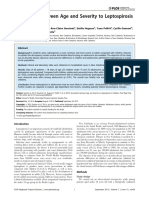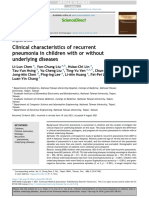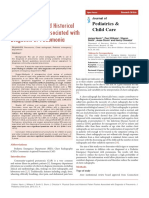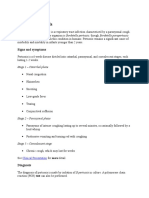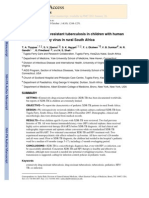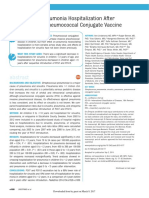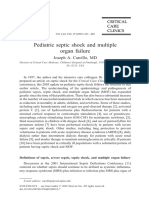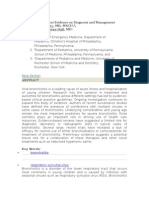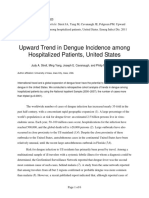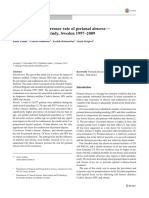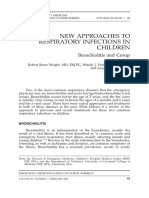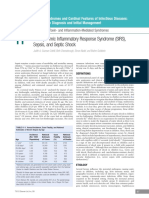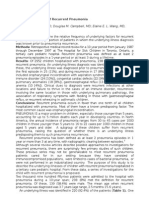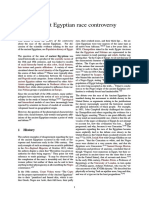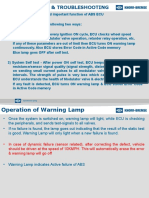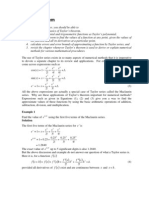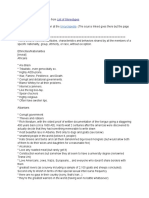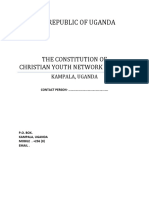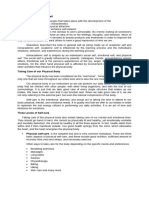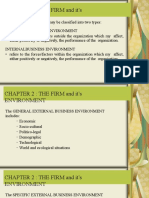0 ratings0% found this document useful (0 votes)
45 viewsBronchiectasis New Zealand
Bronchiectasis New Zealand
Uploaded by
shevinesaThis study estimated the incidence of bronchiectasis in New Zealand children between 2001-2002. It found an overall incidence of 3.7 cases per 100,000 children per year, which is high compared to other developed countries. Incidence was highest among Pacific children at 17.8 cases per 100,000 per year. Most cases were diagnosed in early childhood but had symptoms for over two years prior to diagnosis. The findings suggest bronchiectasis disproportionately affects some ethnic groups in New Zealand and is often not diagnosed until the disease is well established.
Copyright:
© All Rights Reserved
Available Formats
Download as PDF, TXT or read online from Scribd
Bronchiectasis New Zealand
Bronchiectasis New Zealand
Uploaded by
shevinesa0 ratings0% found this document useful (0 votes)
45 views4 pagesThis study estimated the incidence of bronchiectasis in New Zealand children between 2001-2002. It found an overall incidence of 3.7 cases per 100,000 children per year, which is high compared to other developed countries. Incidence was highest among Pacific children at 17.8 cases per 100,000 per year. Most cases were diagnosed in early childhood but had symptoms for over two years prior to diagnosis. The findings suggest bronchiectasis disproportionately affects some ethnic groups in New Zealand and is often not diagnosed until the disease is well established.
Original Description:
bronkiektasis
Copyright
© © All Rights Reserved
Available Formats
PDF, TXT or read online from Scribd
Share this document
Did you find this document useful?
Is this content inappropriate?
This study estimated the incidence of bronchiectasis in New Zealand children between 2001-2002. It found an overall incidence of 3.7 cases per 100,000 children per year, which is high compared to other developed countries. Incidence was highest among Pacific children at 17.8 cases per 100,000 per year. Most cases were diagnosed in early childhood but had symptoms for over two years prior to diagnosis. The findings suggest bronchiectasis disproportionately affects some ethnic groups in New Zealand and is often not diagnosed until the disease is well established.
Copyright:
© All Rights Reserved
Available Formats
Download as PDF, TXT or read online from Scribd
Download as pdf or txt
0 ratings0% found this document useful (0 votes)
45 views4 pagesBronchiectasis New Zealand
Bronchiectasis New Zealand
Uploaded by
shevinesaThis study estimated the incidence of bronchiectasis in New Zealand children between 2001-2002. It found an overall incidence of 3.7 cases per 100,000 children per year, which is high compared to other developed countries. Incidence was highest among Pacific children at 17.8 cases per 100,000 per year. Most cases were diagnosed in early childhood but had symptoms for over two years prior to diagnosis. The findings suggest bronchiectasis disproportionately affects some ethnic groups in New Zealand and is often not diagnosed until the disease is well established.
Copyright:
© All Rights Reserved
Available Formats
Download as PDF, TXT or read online from Scribd
Download as pdf or txt
You are on page 1of 4
ORIGINAL ARTICLE
New Zealand national incidence of bronchiectasis
too high for a developed country
J Twiss, R Metcalfe, E Edwards, C Byrnes
. . . . . . . . . . . . . . . . . . . . . . . . . . . . . . . . . . . . . . . . . . . . . . . . . . . . . . . . . . . . . . . . . . . . . . . . . . . . . . . . . . . . . . . . . . . . . . . . . . . . . . . . . . . . . . . . . . . . . . . . . . . . . . .
See end of article for
authors affiliations
. . . . . . . . . . . . . . . . . . . . . . .
Correspondence to:
Dr J Twiss, Starship
Childrens Hospital, Private
Bag 92024, Auckland,
New Zealand; jacobt@
adhb.govt.nz
Accepted 14 March 2005
Published Online First
4 May 2005
. . . . . . . . . . . . . . . . . . . . . . .
Arch Dis Child 2005;90:737740. doi: 10.1136/adc.2004.066472
Aims: To prospectively estimate the incidence of bronchiectasis among New Zealand (NZ) children, to
consider aetiology and severity, and to evaluate regional and ethnic variation.
Methodology: NZ paediatricians were surveyed monthly for new cases of bronchiectasis during 2001 and
2002 via the NZ paediatric surveillance unit (with coverage of .94% of NZ paediatricians). Notified cases
had their computed tomography scans reviewed and scored for severity. Confirmed cases were followed
up by postal questionnaire one year after diagnosis. Demographic, aetiological, and severity data were
collected.
Results: Ninety nine notifications were received. Sixty five cases were confirmed. An overall incidence of
3.7 per 100 000 under 15 year old children per year was estimated. Incidence was highest in Pacific
children at 17.8 compared with 4.8 in Maori, 1.5 in NZ European, and 2.4 other per 100 000 per year.
Incidence varied significantly by region. The median age at diagnosis was 5.2 years; the majority had
symptoms for more than two years. Eighty three per cent had bilateral disease, with a median of three
lobes affected, mean FEV1 of 77% predicted, and modified Bhalla HRCT score of 18.
Conclusions: The incidence of bronchiectasis is high in NZ children, nearly twice the rate for cystic fibrosis
and seven times that of Finland, the only other country reporting a childhood national rate. Incidence
varied substantially between ethnicities. Most cases developed disease in early childhood and had delayed
diagnosis.
B
ronchiectasis is a morphological diagnosis based on
dilatation of bronchial airways and is associated with
recurrent lower respiratory tract infection, significant
morbidity, and mortality. The incidence of bronchiectasis not
due to cystic fibrosis (CF) may have fallen in the 20th century
with the advent of improved living conditions, vaccination,
and antibiotics. However recent reports of high prevalence,
morbidity, and mortality within certain communities raises
concern.
16
The limited population data that do exist are hard
to compare, due to the use of varying denominators and
methodologies (including case definitions). Good data are
needed to make informed decisions on population health
measures, as well as determining the need and direction of
future research.
Two national bronchiectasis estimates have recently been
reported. In Finland the incidence has been estimated at 0.5
per 100 000 children under 15 years in age per year and 3.9
per 100 000 per year overall.
7
In the United States the
prevalence has been estimated at 52:100 000 overall and
resulted in an additional 1.1 billion US dollars of healthcare
expenditure per annum.
6
Much higher prevalences have been
reported in some communities16:1000 Southwest Alaskan
Native children and 15:1000 central Australian Aborigine
children.
3 8
The impact of bronchiectasis in New Zealand
(NZ) has caused concern for some time but data have largely
been limited to hospitalisation and mortality datareported
at 50 deaths per 100 000 in Maori and Pacific People.
9 10
Compared with asthma, a far more common respiratory
disease, bronchiectasis causes one tenth the hospital admis-
sions and half the number of deaths.
11 12
It results in 75%
more admissions and nearly five times as many deaths as
CF.
11 12
Significant bronchiectasis mortality does not begin
until adulthood in NZ, however it is likely that in many cases
the disease began in childhood.
13
A recent report of high
prevalence in children living in NZs largest city (1:6000
overall with 1:1900 Pacific Island children) increases
concern.
4
The aim of this study is to prospectively estimate the
national incidence of bronchiectasis diagnoses over a two
year period in the 0.85 million NZ children. The study will
also identify regional variation, aetiology, and severity.
METHODS
New cases of bronchiectasis were identified through the NZ
Paediatric Surveillance Unit (NZPSU). Each month partici-
pating clinicians are sent either a reply paid card or an email
(as self nominated) to report new cases of conditions under
surveillance. Bronchiectasis was included on the NZPSU
Report Card for 2001 and 2002.
Case defi ni ti on
N
a high resolution computed tomography (HRCT) consis-
tent with bronchiectasis;
N
(15 years of age at HRCT diagnosis;
N
productive cough daily for .six weeks or for three months
per year for two consecutive years;
N
persistent chest x ray abnormalities; and
N
not due to cystic fibrosis.
Following notification the referring paediatrician was asked
to send the HRCT to the study centre. The cases identity
remained anonymous. Diagnosis was confirmed using the
radiological criteria of Naidich et al
14
and scored using the
modified Bhalla by a single paediatric radiologist (RM) with
no clinical data.
1517
This score has been validated in adult and
Abbreviations: CF, cystic fibrosis; FEV1, forced expiratory volume in
one second; HRCT, high resolution computed tomography; NZPSU, New
Zealand Paediatric Surveillance Unit.
737
www.archdischild.com
paediatric bronchiectasis and assigns a value to each lobe and
the lingula as follows: bronchiectasis extent (03), bronchial
wall dilatation (03) and thickness (03), presence of mucus
in large (01) and small airways (01), air trapping (04),
atelectasis (01), and consolidation (01) resulting in a worst
possible score of 102.
15 16
Postal questionnaires were sent to
the paediatrician one year after notification collecting
demographic details, investigation results, and ascribed
aetiology. The delay was to allow time for investigation
without influencing it. Multiple responses were allowed for
ethnicity data.
18
Incidences were calculated using under 15
year old cases for numerators and NZ 2001 census data for
denominators.
19
Pulmonary function is reported as percen-
tage of predicted (Polgar reference).
20
Prospective ethical
approval was gained. Statistical software package SPSS
version 11.5 (SPSS Inc, Chicago, IL, USA) was used. Chi
square, Kruskal-Wallis, and Spearman (r) were used for non-
parametric data; t test and ANOVA for parametric data.
RESULTS
Ninety nine notifications were received over the two years.
Thirty two were excluded due to: duplication/error (10),
diagnosis outside the study time period or age range (7), no
or non-definitive HRCT (15). Two cases were lost to follow up
leaving 65 confirmed cases, 63 under 15 years of age. Half of
confirmed notifications came from respiratory specialists and
one third from general paediatricians. At diagnosis (median
5.2 years) 40% of cases had cough for >2 years (table 1.) The
median age of reported symptom onset was 2.3 years. Three
quarters had prior hospital admission for other respiratory
illness at a median 1 year of age. Only 8% had no hospital
admissions and 18% were known to have or were diagnosed
with bronchiectasis at their first admission. Ninety per cent
were NZ born with 5% born outside the Pacific.
I nci dence esti mates
An overall incidence of 3.7 per 100 000 under 15 year olds per
year is estimated. Incidence varied with ethnicity (1.517.8
per 100 000 per year, p,0.001; table 2), highest in Pacific
children and by region (08.3 per 100 000 per year, p =0.03;
fig 1). More females were reported (37/65 of cases, difference
not significant, p =0.09).
Aeti ol ogy
Notifiers reported aetiology to be unknown in 54% of cases,
post infectious in 22%, as a result of oncological disease or
treatment in 11%, aspiration 6%, and primary immunodefi-
ciency 6% (table 3).
Those of unknown aetiology were older (median 8.3 v 3.6
years, p =0.02), had a longer duration of cough (3.0 v 1.0
years, p =0.002) and a trend to milder disease (median CT
score 14 v 21, p =0.11). Comorbidities were volunteered (not
requested) in 10 casesprematurity (8%), trisomy 21 (5%),
congenital heart disease (2%), and progressive neuro-
muscular disease (2%).
Pul monary funct i on
Ninety per cent (28/31) of children aged over 6 years had
spirometry. The mean forced vital capacity was 85%
predicted, mean forced expiratory volume in one second
Table 1 Age, sex, and past history
Male:female ratio 28:37 (54% female)
Age at diagnosis Median 5.2 years (range 0.515
years)
Age at onset of cough Median 2.3 years (range 014
years)
Duration of symptoms Median 1.0 years (range 6 weeks to
14 years)
Age first (non-bronchiectasis)
respiratory hospitalisation (74%)
Median 1.0 years (range 1 month to
13 years)
29% bronchopneumonia
33% lobar pneumonia
38% bronchiolitis
Table 2 Ethnic distribution and incidence
Ethnicity
NZ ,15 year
old population
(multiple choices,
2001 census)
Proportion
of cases
Incidence
(per 100 000
,15 year olds
per year)
Pacific
Peoples
11% 50% 17.8
Maori 23% 30% 4.8
NZ European 73% 28% 1.5
Other 8% 5% 2.4
p,0.001
Table 3 Aetiology of confirmed cases
Aetiology % (n)
Unknown/idiopathic 54 (35)
Post infectious 22 (6 adenovirus, 3 pertussis, 1 tuberculosis,
4 other)
Post oncology 11 (5 leukaemia, 2 lymphoma; 1 had bone
marrow transplant)
Aspiration 6 (3 chronic aspiration, 1 retained peanut)
Primary
immunodeficiency
6 (4, all humoral deficiencies)
<0.5/100 000/year
0.51.5/100 000/year
Incidence rates:
1.52.5/100 000/year
2.53.5/100 000/year
3.54.5/100 000/year
>45/100 000/year
NORTH ISLAND
SOUTH ISLAND
Gisborne
Hawkes Bay
Wairarapa
Taranaki
Nelson
Marlborough
Manawatu-Wanganui
Wellington
Canterbury
Otago
West Coast
Fiordland
Stewart Island
Southland
Waikato
Auckland
Northland
Coromandel
Central Plateau
Bay of
Plenty
Figure 1 Regional incidence.
738 Twiss, Metcalfe, Edwards, et al
www.archdischild.com
(FEV1) 77% predicted, and mean forced expiratory flow 25
75% of 76% predicted. Half had an FEV1 ,80% and a quarter
,60%. No difference in lung function was found between sex
(p=0.13), ethnicities (p =0.72), or aetiologies (p =0.62).
Radi ol ogy
Eighty three per cent of cases had bilateral bronchiectasis,
61% had three or more of the five lobes involved and only
16% had unilobular disease. Lower lobes were most
frequently and most severely affected (fig 2). The median
modified Bhalla score was 18 (range 465) with no
significant differences between sex (p =0.67), ethnicities
(p=0.93), aetiologies (p =0.47), or by age (r =20.15). The
median scores (ranges) for CT score components (sum of
lobes) were: bronchiectasis extent, 5 (216); bronchial
dilatation, 4 (116); wall thickness, 2 (07); centrilobular
mucus, 0 (04); large airway mucus, 0 (03); atelectasis, 2
(06); and consolidation, 0 (05). FEV1 correlated modestly
with HRCT score (r =20.38, p =0.04).
I nvesti gati ons
A full blood count was reported in 97%, quantitative
immunoglobulins in 88% (30% elevated, 2% low), specific
antibody responses in 46%, immunoglobulin subclasses in
26%, complement in 25%, and nitrozine blue test in 14% of
cases. Cilia were assessed in 8% (all normal). Reflux/
aspiration was assessed in 28% of cases (45% abnormal).
Bacterial respiratory cultures grew Haemophilus influenzae in
48%, Streptococcus pneumoniae in 14%, Moraxella catarrhalis in
8%, Staphylococcus aureus in 8%, Pseudomonas aeruginosa in 3%,
and were negative/not done in 25%. Cystic fibrosis was not
excluded in 27% of cases; 65% of these had a definitive
aetiology and the remaining were non-European with neither
Pseudomonas aeruginosa nor Staphylococcus aureus.
DI SCUSSI ON
The principle outcome is a minimum incidence of non-CF
bronchiectasis in the NZ under 15 year old population of 3.7
per 100 000 per year. This rate is seven times higher than the
only other comparable national study, 0.49 per 100 000
Finnish under 15 year old children,
7
and equates to one in
1700 births being diagnosed with bronchiectasis before the
age of 15 (about twice the CF rate, 1:3179).
21
If we speculate
that the incidence rate is static and that all children with
bronchiectasis survive to 15 years of age, then our figure
equates to a prevalence of 1:3000 children overall and 1:625
Pacific children.
Ethnic differences in disease incidence, morbidity, and
mortality are phenomena of most developed countries. Grant
et al reported the Auckland hospitalisation rate for pneumo-
nia was twice as common in Maori and five times as common
in Pacific than in NZ European children.
22
Pacific and Maori
children hospitalised also had more severe pneumonia.
23
We
found the incidence to be three times higher in Maori and 12
times higher in Pacific Peoples compared with those of
European ethnicity, but with no differences in severity or
aetiology. Nearly 90% of Pacific children came from
Auckland, which holds the largest Polynesian community
in the world. Pacific Peoples are not indigenous to NZ but
have immigrated in large numbers since World War II. They
are a young (median age 21 years) and rapidly growing
population with twice the national unemployment rate and
are seven times as likely to live in a dwelling with more than
two occupants per bedroom.
19
Assignment of aetiology was made by the referring doctor
(unverifiable by the authors) one year after diagnosis.
Published case series have variable aetiological distributions
as a result of the different criteria used, source populations,
and degree of investigation. Over half the cases in this study
were of unknown aetiology. The unknowns were older,
had a longer duration of symptoms, tended to have more
investigations, and milder disease (CT score), perhaps a
reflection of later presentation and a colder trail for
causation. Some unknown aetiology might have a cause
determined with further investigation. Specific antibody
assessment, a key element in humoral immunity evaluation,
had not been performed in half of the cases. Cilia studies
were rarely obtained because of poor availability. All those
without a definitive aetiology and not tested for CF were non-
European, had normal growth, and did not grow
Staphylococcus or Pseudomonas species making CF unlikely.
Although NZ has had universal neonatal CF screening since
1982, clinical suspicion still warrants its exclusion.
24
The
significant number of cases in association with oncological
disease deserves further review.
This study is limited by its reliance on all cases being
diagnosed and then notified. A paediatrician would be
expected to be involved in the diagnosis of a child with
bronchiectasis and the NZPSU system includes an estimated
94% of NZ paediatricians. Half the notifications came from
respiratory specialists, one third from general paediatricians
with no significant differences in aetiology, severity, or
investigations found between notifying specialty.
Surveillance unit study sensitivity varies by condition but
not region or specialty with reported sensitivities of 6289%
in other NZPSU studies.
25
Given that respiratory symptoms
are common in childhood, and bronchiectasis symptoms are
non-specific, a significant proportion of cases are likely to go
undiagnosed, particularly in Maori and Pacific Peoples with
poorer access to health care.
23
Fifteen notifications were
excluded due to not meeting the HRCT criteria (one not
having had a CT); further review and repeat radiology may
have confirmed the diagnosis. We believe our incidence
figure should be taken as a minimum.
Although one third of cases had cough for >3 years at
diagnosis, children in this study were diagnosed younger and
with less delay than reported in the previous Auckland study
4
and in a recent large UK series,
26
perhaps reflecting increasing
awareness of the disease and earlier referral. However NZ
children have more extensive disease than those in overseas
case series and the childhood incidence is high, particularly
in Pacific children.
35
A decade ago, an NZ Public Health Commission report of
the health of NZ Pacific Peoples identified bronchiectasis as a
major cause of hospitalisation and the seventh highest cause
of death (women).
27
The Ministry of Health concluded that
the report provided a baseline for future monitoring and
policy development.
28
In the same year the NZ Government
established child (and Maori) health as priority gain areas.
The results of this study suggest the situation is unlikely to be
Figure 2 Proportion of cases with each lobe (and lingual) affected.
National incidence of bronchiectasis 739
www.archdischild.com
better. If we are to improve, prevention of childhood
bronchiectasis must be a priority, and early identification
and intervention is vital. We hope this study which
documents a high minimum incidence figure, will contribute
positively towards that goal.
ACKNOWLEDGEMENTS
We are indebted to NZ paediatricians, and grateful to the NZPSU,
Joan Mary Reynolds Fellowship, and Child Health Research
Foundation for their support of this study.
Authors affiliations
. . . . . . . . . . . . . . . . . . . . .
J Twiss, E Edwards, C Byrnes, Starship Childrens Hospital, Auckland
District Health Board, Auckland, New Zealand
J Twiss, R Metcalfe, E Edwards, C Byrnes, University of Auckland,
Auckland, New Zealand
Competing interests: none declared
REFERENCES
1 Karakoc GB, Yilmaz M, Altintas DU, et al. Bronchiectasis: still a problem.
Pediatr Pulmonol 2001;32:1758.
2 Scala R, Aronne D, Palumbo U, et al. Prevalence, age distribution and
aetiology of bronchiectasis: a retrospective study on 144 symptomatic
patients. Monaldi Arch Chest Dis 2000;55:1015.
3 Singleton R, Morris A, Redding G, et al. Bronchiectasis in Alaska Native
children: causes and clinical courses. Pediatr Pulmonol 2000;29:1827.
4 Edwards EA, Asher MI, Byrnes CA. Paediatric bronchiectasis in the twenty first
century: experience of a tertiary childrens hospital in New Zealand. J Paediatr
Chld Hlth 2003;39:11117.
5 Chang AB, Masel JP, Boyce NC, et al. Non-CF bronchiectasis: clinical and
HRCT evaluation. Pediatr Pulmonol 2003;35:47783.
6 Weycker D, Edelsberg J, Oster G, et al. Prevalence and economic costs of
bronchiectasis. American Thoracic Society International Conference, May
2126 2004, Orlando, Florida, USA. Amer J Resp Crit Care Med
2004;169(7 supplement):330.
7 Sayajakangas O, Keistinen T, Tuuponen TO, et al. Evaluation of the incidence
and age distribution of bronchiectasis from the Finish Hospital Discharge
Register. Cent Eur J Public Health 1998;6:2357.
8 Chang AB, Grimwood K, Mulholland EK, et al. Bronchiectasis in indigenous
children in remote Australian communities. Med J of Australia
2002;177:2004.
9 Kolbe J, Wells AU. Bronchiectasis: a neglected cause of respiratory morbidity
and mortality. Respirology 1996;1:2215.
10 ONeill MKJ, Wells A. Bronchiectasis in New Zealand: a dying disease or
neglected epidemic? Am J Respir Crit Care Med 1995;151(A201).
11 New Zealand Health Information Service. Mortality and demographic data
2000: New Zealand Ministry of Health 2004.
12 New Zealand Health Information Service. Selected morbidity data for
publicly funded hospitals 2000/01, New Zealand Ministry of Health, 2004.
13 Pasteur MC, Helliwell SM, Houghton SJ, et al. An investigation into causative
factors in patients with bronchiectasis. Am J Respir Crit Care Med
2000;162:127784.
14 Naidich DP, McCauley DI, Khouri NF, et al. Computed tomography of
bronchiectasis. J Comput Assist Tomogr 1982;6:43744.
15 Edwards EA, Metcalfe R, Milne DG, et al. Retrospective review of children
presenting with non cystic fibrosis bronchiectasis: HRCT features and clinical
relationships. Pediatr Pulmonol 2003;36:8793.
16 Roberts HR, Wells AU, Milne DG, et al. Airflow obstruction in bronchiectasis:
correlation between computed tomography features and pulmonary tests.
Thorax 2000;55:198204.
17 Bhalla M, Turcois N, V A. Cystic fibrosis: scoring system with thin-section CT.
Radiology 1991;179:7838.
18 Statistics New Zealand. NZ standard classification of ethnicity 1996 (1996).
19 Statistics New Zealand. New Zealand Census 2001 (2003).
20 Polgar G, Promadhat V. Pulmonary function testing in children: techniques
and standards. Philadelphia: WB Saunders, 1971.
21 Wesley AW, Stewart AW. Cystic fibrosis in New Zealand: incidence and
mortality. NZ Med J 1985;98:3213.
22 Grant CC, Scragg R, Tan D, et al. Hospitilization for pneumonia in children in
Auckland, New Zealand. J Paed Child Hlth 1998;34:3559.
23 Grant CC, Pati A, Tan D, et al. Ethnic comparisons of disease severity in
children hospitalized with pneumonia in New Zealand. J Paed Child Hlth
2001;37:327.
24 Wesley AW, Smith PA, Elliott RB. Experience with neonatal screening for
cystic fibrosis in New Zealand using measurement of immunoreactive
trypsinogen. Aust Paed J 1989;25:1515.
25 Gazarian M, Williams K, Elliot E, et al. Evaluation of a national surveillance
unit. Arch Dis Child 1999;80:217.
26 Eastham KM, Fall AJ, Mitchell L, et al. The need to redefine non-cystic fibrosis
bronchiectasis in childhood. Thorax 2004;59:3247.
27 Public Health Commission. The health of Pacific Islands People. Wellington:
Public Health Commission, 1994.
28 New Zealand Ministry of Health. Pacific Island health information.
Wellington: Ministry of Health, 1996.
What i s al ready known on thi s topi c
N
Non-CF bronchiectasis, a once common condition, is
widely believed to have fallen in incidence since the
19th century.
N
Recently high occurrences have been reported within
certain communities including Auckland Pacific Island
children, south Alaskan Native children, and central
Australian Aborigine children.
N
International whole population data with which to
place these communities in context are lacking. There is
only one contemporary published national study in
existence reporting an incidence of 0.5 per 100 000
Finnish children per year.
What thi s study adds
N
This is the first prospective national study of bronch-
iectasis occurrence and is strengthened by requiring
both clinical and CT evidence of disease.
N
It describes a high minimum incidence in New Zealand
children (3.7 per 100 000 under 15 year olds per
year) with significant regional and ethnic disparity.
N
The study provides a baseline for future regional and
temporal comparison and has utility in the develop-
ment of preventative and interventional strategies.
740 Twiss, Metcalfe, Edwards, et al
www.archdischild.com
You might also like
- Autopsy ReportDocument4 pagesAutopsy Reporteethen33% (3)
- Art App Critique Paper - SuperDocument5 pagesArt App Critique Paper - SuperAnonymous BBs1xxk96VNo ratings yet
- Lush MarketingDocument9 pagesLush MarketingMyassignmentPro VideoNo ratings yet
- Trend and Outcome of Sepsis in ChildrenDocument8 pagesTrend and Outcome of Sepsis in ChildrenGunduz AgaNo ratings yet
- Association Between Age and Severity To Leptospirosis in ChildrenDocument5 pagesAssociation Between Age and Severity To Leptospirosis in ChildrenNurafni DewiNo ratings yet
- Pneumonia Complicated by Congestive Heart Failure in Nigerian ChildrenDocument5 pagesPneumonia Complicated by Congestive Heart Failure in Nigerian ChildrenDewi KnrsNo ratings yet
- 1 s2.0 S0929664621003892 MainDocument8 pages1 s2.0 S0929664621003892 Mainrheynamaulidar rumoninNo ratings yet
- Fibrosis QuísticaDocument6 pagesFibrosis QuísticaKATHERINE MORALES MONTOYANo ratings yet
- JPCC 2380 0534 01 0002 PDFDocument4 pagesJPCC 2380 0534 01 0002 PDFLuiggi D. Chambi MaidaNo ratings yet
- Underlying Congenital Heart Disease in Nigerian Children With PneumoniaDocument6 pagesUnderlying Congenital Heart Disease in Nigerian Children With Pneumonianisa100% (1)
- Prevalence and Factors Associated With Pulmonary Arterial Hypertension Pah in Sickle Cell Children Residing in Yaound CameroonDocument7 pagesPrevalence and Factors Associated With Pulmonary Arterial Hypertension Pah in Sickle Cell Children Residing in Yaound CameroonScivision PublishersNo ratings yet
- Wong 2013Document6 pagesWong 2013fandyNo ratings yet
- Signs and Symptoms: Stage 1 - Catarrhal PhaseDocument8 pagesSigns and Symptoms: Stage 1 - Catarrhal PhasesyamqomNo ratings yet
- Adolescents With Tuberculosis-A Review of 145 Cases, 2016Document5 pagesAdolescents With Tuberculosis-A Review of 145 Cases, 2016Yoseph Arif Putra100% (1)
- The Systemic Inflammatory Response Syndrome (SIRS), Sepsis, and Septic ShockDocument11 pagesThe Systemic Inflammatory Response Syndrome (SIRS), Sepsis, and Septic ShockRilano UmbohNo ratings yet
- MS27x 17 PDFDocument9 pagesMS27x 17 PDFijasrjournalNo ratings yet
- Practice Essential2Document19 pagesPractice Essential2Muhammad Khairuna SyahPutraNo ratings yet
- Seminar: Eloi Marijon, Mariana Mirabel, David S Celermajer, Xavier JouvenDocument12 pagesSeminar: Eloi Marijon, Mariana Mirabel, David S Celermajer, Xavier JouvenhotasioclsNo ratings yet
- Clinical Profile of Acute BronchiolitisDocument4 pagesClinical Profile of Acute BronchiolitisInternational Journal of Innovative Science and Research TechnologyNo ratings yet
- Jurnal TBC Inter 1Document5 pagesJurnal TBC Inter 1sekti lindaNo ratings yet
- 2020 Bidirectional Association Between Tuberculosis and SarcoidosisDocument8 pages2020 Bidirectional Association Between Tuberculosis and SarcoidosisLCCNo ratings yet
- PGH 107 04 198Document4 pagesPGH 107 04 198shjahsjanshaNo ratings yet
- Prevention and Treatment of Seasonal Influenza: Clinical PracticeDocument7 pagesPrevention and Treatment of Seasonal Influenza: Clinical PracticeDias PradikaNo ratings yet
- Extensively Drug-Resistant Tuberculosis in Children With HumanDocument12 pagesExtensively Drug-Resistant Tuberculosis in Children With Humanromeoenny4154No ratings yet
- Comparative Analysis of Severe Pediatric and Adult Leptospirosis in Sa o Paulo, BrazilDocument3 pagesComparative Analysis of Severe Pediatric and Adult Leptospirosis in Sa o Paulo, BrazilShofura AzizahNo ratings yet
- Exp 1 en Final 04jan19Document21 pagesExp 1 en Final 04jan19Danielle SarpongNo ratings yet
- Keating 2010Document7 pagesKeating 2010DR. OSORIONo ratings yet
- Sinusitis and Pneumonia Hospitalization After Introduction of Pneumococcal Conjugate VaccineDocument11 pagesSinusitis and Pneumonia Hospitalization After Introduction of Pneumococcal Conjugate VaccineHanida Rahmah TaminNo ratings yet
- Lepto SpirosDocument8 pagesLepto SpirosNisa UcilNo ratings yet
- Acute Respiratory InfectionsDocument1 pageAcute Respiratory InfectionsLynn Marie P. SimporiosNo ratings yet
- I. Epidemiology and Genetics of AsthmaDocument7 pagesI. Epidemiology and Genetics of AsthmaVasincuAlexandruNo ratings yet
- Pediatric Septic Shock and Multiple Organ FailureDocument28 pagesPediatric Septic Shock and Multiple Organ FailureAyu AmarihatiNo ratings yet
- Risk Factors For Extra-Pulmonary Tuberculosis Compared To Pulmonary TuberculosisDocument6 pagesRisk Factors For Extra-Pulmonary Tuberculosis Compared To Pulmonary TuberculosisLily SmithNo ratings yet
- Clinico-Epidemiological Profile of Childhood Cutaneous TuberculosisDocument7 pagesClinico-Epidemiological Profile of Childhood Cutaneous TuberculosisFajar SatriaNo ratings yet
- Sepsis in Older PatientsDocument8 pagesSepsis in Older PatientsFajar WasilahNo ratings yet
- Joseph J. Zorc Caroline Breese Hall: Bronchiolitis: Recent Evidence On Diagnosis and Management, MD, Msce, ,, MDDocument10 pagesJoseph J. Zorc Caroline Breese Hall: Bronchiolitis: Recent Evidence On Diagnosis and Management, MD, Msce, ,, MDArie PrasetyowatiNo ratings yet
- Pulmonary Nontuberculous Mycobacterial Disease Prevalence and Clinical FeaturesDocument6 pagesPulmonary Nontuberculous Mycobacterial Disease Prevalence and Clinical FeaturesRiski DohartuaNo ratings yet
- Bacteriological Prevalence Tuberculosis Among Children Seen Health Facilities Nasarawa State Nigeria 2576 8484 EAST 18 121Document5 pagesBacteriological Prevalence Tuberculosis Among Children Seen Health Facilities Nasarawa State Nigeria 2576 8484 EAST 18 121fatimakh462No ratings yet
- Literature Review of Pneumonia Under Five YearDocument6 pagesLiterature Review of Pneumonia Under Five Yeare9xy1xsv100% (1)
- Upward Trend in Dengue Incidence Among Hospitalized Patients, United StatesDocument6 pagesUpward Trend in Dengue Incidence Among Hospitalized Patients, United StatesArhaMozaNo ratings yet
- Bronquiolitis (1) - Lancet 2006Document11 pagesBronquiolitis (1) - Lancet 2006Gio Muñoz MarinNo ratings yet
- Nationwide Prevalence of Sporadic and Familial Idiopathic Pulmonary Fibrosis: Evidence of Founder Effect Among Multiplex Families in FinlandDocument5 pagesNationwide Prevalence of Sporadic and Familial Idiopathic Pulmonary Fibrosis: Evidence of Founder Effect Among Multiplex Families in FinlandNailatul Izza HumammyNo ratings yet
- Prevalence CHDDocument7 pagesPrevalence CHDMuhammad AfifNo ratings yet
- Resurgence of Diphtheria: Clinical Profile and Outcome - A Retrospective Observational StudyDocument4 pagesResurgence of Diphtheria: Clinical Profile and Outcome - A Retrospective Observational StudyLestari LifaNo ratings yet
- Agostini 2016 - The Prevention of EpilepsyDocument2 pagesAgostini 2016 - The Prevention of EpilepsyMark CheongNo ratings yet
- Tuberculosis Disease in ChildrenDocument16 pagesTuberculosis Disease in ChildrenfandyNo ratings yet
- Prevalence and Recurrence Rate of Perianal Abscess - A Population-Based Study, Sweden 1997 - 2009Document5 pagesPrevalence and Recurrence Rate of Perianal Abscess - A Population-Based Study, Sweden 1997 - 2009Ridha Aswina DalimuntheNo ratings yet
- Crup 3Document22 pagesCrup 3Wilber Martin BaltodanoNo ratings yet
- High Risk of Congenital Hypothyroidism in Multiple PregnanciesDocument7 pagesHigh Risk of Congenital Hypothyroidism in Multiple PregnanciesEgidiaEkaRikaNo ratings yet
- ICAR: Allergic Rhinitis: V.B. Incidence and Prevalence of Allergic Rhinitis in ChildrenDocument31 pagesICAR: Allergic Rhinitis: V.B. Incidence and Prevalence of Allergic Rhinitis in ChildrenSantiago OrricoNo ratings yet
- 3 Septicshock SIRS PDFDocument11 pages3 Septicshock SIRS PDFRhobbigfirly UnggulNo ratings yet
- Jurnal 2Document11 pagesJurnal 2elvanNo ratings yet
- Epidemiology of Asthma: ReviewDocument5 pagesEpidemiology of Asthma: Reviewdella psNo ratings yet
- Neonatal Sepsis in The Very Low Birth Weight Preterm Infants: Part 1: Review of Patho-PhysiologyDocument10 pagesNeonatal Sepsis in The Very Low Birth Weight Preterm Infants: Part 1: Review of Patho-PhysiologyjukunkNo ratings yet
- Leprosy Among Children Under 15 Years of Age: Literature ReviewDocument8 pagesLeprosy Among Children Under 15 Years of Age: Literature ReviewCecep HermawanNo ratings yet
- Adolescent Tuberculosis: A Challenge and Opportunity To Prevent Community TransmissionDocument6 pagesAdolescent Tuberculosis: A Challenge and Opportunity To Prevent Community Transmissiondiamond tiktokNo ratings yet
- Emergency Department Management of Pediatric Patients With Cyanotic Heart Disease and FeverDocument8 pagesEmergency Department Management of Pediatric Patients With Cyanotic Heart Disease and FeverRizky Ferrian FerdiansyahNo ratings yet
- Abdullah F. Owayed, MD Douglas M. Campbell, MD Elaine E. L. Wang, MD, FRCPCDocument8 pagesAbdullah F. Owayed, MD Douglas M. Campbell, MD Elaine E. L. Wang, MD, FRCPCadiospernitiNo ratings yet
- Pulmonary Tuberculosis in Infants Under One Year of AgeDocument5 pagesPulmonary Tuberculosis in Infants Under One Year of AgeNurul SahidaNo ratings yet
- Staphylococcus Aureus Infections in New Zealand, 2000-2011Document6 pagesStaphylococcus Aureus Infections in New Zealand, 2000-2011Mark ReinhardtNo ratings yet
- SchollinAsk2019 Article ClinicalPresentationOfIntussusDocument9 pagesSchollinAsk2019 Article ClinicalPresentationOfIntussusAnisa GayatriNo ratings yet
- 2008, Pertussis ReviewDocument12 pages2008, Pertussis ReviewValTazzeeNo ratings yet
- Heart Valve Disease: State of the ArtFrom EverandHeart Valve Disease: State of the ArtJose ZamoranoNo ratings yet
- Bullous Keratopathy PRDocument12 pagesBullous Keratopathy PRshevinesaNo ratings yet
- Kolumna Vertebra: Oleh Gunawan SKMDocument28 pagesKolumna Vertebra: Oleh Gunawan SKMshevinesaNo ratings yet
- Patologi Tulang: Dr. Saukani Gumay, Sppa (K)Document26 pagesPatologi Tulang: Dr. Saukani Gumay, Sppa (K)shevinesaNo ratings yet
- Anestesi Lokal Pada Lesi Superfisial: Huntal NapoleonDocument12 pagesAnestesi Lokal Pada Lesi Superfisial: Huntal NapoleonshevinesaNo ratings yet
- Tuberculosis, Bronchiectasis and Chronic Airflow ObstructionDocument6 pagesTuberculosis, Bronchiectasis and Chronic Airflow ObstructionshevinesaNo ratings yet
- Ancient Egyptian Race ControversyDocument13 pagesAncient Egyptian Race ControversyAlison_VicarNo ratings yet
- Nursing Arts LO Module 3Document8 pagesNursing Arts LO Module 3AmberpersonNo ratings yet
- 7 Corena S4 R 46Document3 pages7 Corena S4 R 46Mudabbir Shan AhmedNo ratings yet
- ABS DiagnosticsDocument11 pagesABS DiagnosticsRaghu NaathNo ratings yet
- Taylor SeriesDocument7 pagesTaylor SeriesSaima NasirNo ratings yet
- EquiprobabilityDocument2 pagesEquiprobabilitydanny222No ratings yet
- (News Writing) President Clinton Visits Palo Alto CollegeDocument1 page(News Writing) President Clinton Visits Palo Alto CollegeMark James GonzalesNo ratings yet
- Six Famous Philosopher What They Can: Teach Us About Modern Societies?Document3 pagesSix Famous Philosopher What They Can: Teach Us About Modern Societies?rajesh kumarNo ratings yet
- Zebbo Research Proposal On Air ZimbabweDocument13 pagesZebbo Research Proposal On Air ZimbabweCourage JuwawoNo ratings yet
- Property Law Assignment Semester-V Mortgage: II II II II IDocument25 pagesProperty Law Assignment Semester-V Mortgage: II II II II IAanand SinghNo ratings yet
- TEC-jalousy at Work PDFDocument26 pagesTEC-jalousy at Work PDFalebrenesalvaradoNo ratings yet
- List of StereotypesDocument32 pagesList of StereotypesArjun KumarNo ratings yet
- I. Objective: at The End of The Lesson, The Students Are Expected ToDocument2 pagesI. Objective: at The End of The Lesson, The Students Are Expected ToGerome LopezNo ratings yet
- Guide To Mass EvidenceDocument229 pagesGuide To Mass EvidenceErik C BryanNo ratings yet
- Edited Copy Christian Youth Const.Document26 pagesEdited Copy Christian Youth Const.IGGA ELIANo ratings yet
- Stroke in AusieDocument9 pagesStroke in AusieAnna AzizahNo ratings yet
- Lesson 4 The Physical SelfDocument5 pagesLesson 4 The Physical SelfLerramie Dela PeñaNo ratings yet
- Rebt Homework AssignmentsDocument10 pagesRebt Homework AssignmentsvcfqlvmpdNo ratings yet
- Jnana-Ganga EngDocument38 pagesJnana-Ganga EngdrsubramanianNo ratings yet
- Reference Sheet (Grade 5) WeslandiaDocument5 pagesReference Sheet (Grade 5) Weslandiaabdelrahman albreimNo ratings yet
- Alopi Prasad and Sons v. Union of IndiaDocument10 pagesAlopi Prasad and Sons v. Union of Indiasudhanshu chakravartiNo ratings yet
- Have STH Done FileDocument1 pageHave STH Done FileSonia mcNo ratings yet
- English Qizil QaydalarDocument5 pagesEnglish Qizil QaydalarLəman ƏliyevaNo ratings yet
- Second Language Learning: A Case Study On RongmeiDocument10 pagesSecond Language Learning: A Case Study On RongmeiTJPRC Publications0% (1)
- Father Mychal Judge HomilyDocument7 pagesFather Mychal Judge HomilygerrymattinglyNo ratings yet
- Dzieło ListopadDocument3 pagesDzieło Listopadpaulina macienkoNo ratings yet
- CHAP 2 - Firm and Its EnvironmentDocument19 pagesCHAP 2 - Firm and Its EnvironmentjoeromesantosNo ratings yet

